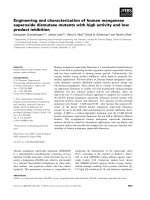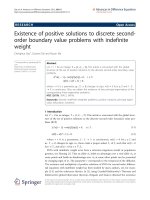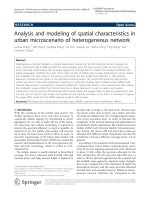Báo cáo toán học: " Existence and multiplicity of solutions for nonlocal p(x)-Laplacian equations with nonlinear Neumann boundary conditions" ppt
Bạn đang xem bản rút gọn của tài liệu. Xem và tải ngay bản đầy đủ của tài liệu tại đây (245.39 KB, 21 trang )
This Provisional PDF corresponds to the article as it appeared upon acceptance. Fully formatted
PDF and full text (HTML) versions will be made available soon.
Existence and multiplicity of solutions for nonlocal p(x)-Laplacian equations
with nonlinear Neumann boundary conditions
Boundary Value Problems 2012, 2012:1 doi:10.1186/1687-2770-2012-1
Erlin Guo ()
Peihao Zhao ()
ISSN 1687-2770
Article type Research
Submission date 29 August 2011
Acceptance date 4 January 2012
Publication date 4 January 2012
Article URL />This peer-reviewed article was published immediately upon acceptance. It can be downloaded,
printed and distributed freely for any purposes (see copyright notice below).
For information about publishing your research in Boundary Value Problems go to
/>For information about other SpringerOpen publications go to
Boundary Value Problems
© 2012 Guo and Zhao ; licensee Springer.
This is an open access article distributed under the terms of the Creative Commons Attribution License ( />which permits unrestricted use, distribution, and reproduction in any medium, provided the original work is properly cited.
Existence and multiplicity of solutions
for nonlocal p(x)-Laplacian equations
with nonlinear Neumann boundary
conditions
Erlin Guo
∗
and Peihao Zhao
School of Mathematics and Statistics, Lanzhou University,
Lanzhou 730000, P. R. China
Corresponding author:
Email address:
Abstract
In this article, we study the nonlocal p(x)-Laplacian problem of the
following form
a
Ω
1
p(x)
|∇u|
p(x)
+ |u|
p(x)
dx
−div(|∇u|
p(x)−2
∇u) + |u|
p(x)−2
u
= b
Ω
F (x, u) dx
f(x, u) in Ω
a
Ω
1
p(x)
|∇u|
p(x)
+ |u|
p(x)
dx
|∇u|
p(x)−2
∂u
∂ν
= g(x, u) on ∂Ω,
where Ω is a smooth bounded domain and ν is the outward normal
vector on the boundary ∂Ω, and F (x, u) =
u
0
f(x, t)dt. By using the
variational method and the theory of the variable exponent Sobolev
1
space, under appropriate assumptions on f, g, a and b, we obtain
some results on existence and multiplicity of solutions of the prob-
lem.
Mathematics Subject Classification (2000): 35B38; 35D05;
35J20.
Keywords: critical points; p(x)-Laplacian; nonlocal problem; vari-
able exponent Sobolev spaces; nonlinear Neumann boundary condi-
tions.
1 Introduction
In this article, we consider the following problem
(P )
a
Ω
1
p(x)
|∇u|
p(x)
+ |u|
p(x)
dx
−div(|∇u|
p(x)−2
∇u) + |u|
p(x)−2
u
= b
Ω
F (x, u) dx
f(x, u) in Ω
a
Ω
1
p(x)
|∇u|
p(x)
+ |u|
p(x)
dx
|∇u|
p(x)−2
∂u
∂ν
= g(x, u) on ∂Ω,
where Ω is a smooth bounded domain in R
N
, p ∈ C(Ω) with 1 < p
−
:=
inf
Ω
p(x) ≤ p(x) ≤ p
+
:= sup
Ω
p(x) < N, a(t) is a continuous real-valued
function, f : Ω × R → R, g : ∂Ω × R → R satisfy the Caratheodory condition,
and F (x, u) =
u
0
f(x, t)dt. Since the equation contains an integral related to
the unknown u over Ω, it is no longer an identity pointwise, and therefore is
often called nonlocal problem.
Kirchhoff [1] has investigated an equation
ρ
∂
2
u
∂t
2
−
P
0
h
+
E
2L
L
0
∂u
∂x
2
dx
∂
2
u
∂x
2
= 0,
which is called the Kirchhoff equation. Various equations of Kirchhoff type have
been studied by many authors, especially after the work of Lions [2], where a
2
functional analysis framework for the problem was proposed; see e.g. [3–6] for
some interesting results and further references. In the following, a key work
on nonlocal elliptic problems is the article by Chipot and Rodrigues [7]. They
studied nonlo cal boundary value problems and unilateral problems with several
applications. And now the study of nonlocal elliptic problem has already been
extended to the case involving the p-Laplacian; see e.g. [8, 9]. Recently, Autuori,
Pucci and Salvatori [10] have investigated the Kirchhoff type equation involving
the p(x)-Laplacian of the form
u
tt
− M
Ω
1
p(x)
|∇u|
p(x)
dx
p(x)
u + Q(t, x, u, u
t
) + f(x, u) = 0.
The study of the stationary version of Kirchhoff type problems has received
considerable attention in recent years; see e.g. [5, 11–16].
The operator
p(x)
u = div(|∇u|
p(x)−2
∇u) is called p(x)-Laplacian, which
becomes p-Laplacian when p(x) ≡ p (a constant). The p(x)-Laplacian possesses
more complicated nonlinearities than p-Laplacian. The study of various mathe-
matical problems with variable exponent are interesting in applications and raise
many difficult mathematical problems. We refer the readers to [17–23] for the
study of p(x)-Laplacian equations and the corresponding variational problems.
Corrˆea and Figueiredo [13] presented several sufficient conditions for the
existence of positive solutions to a class of nonlocal boundary value problems
of the p-Kirchhoff type equation. Fan and Zhang [20] studied p(x)-Laplacian
equation with the nonlinearity f satisfying Ambrosetti–Rabinowitz condition.
The p(x)-Kirchhoff type equations with Dirichlet boundary value problems have
been studied by Dai and Hao [24], and much weaker conditions have been given
by Fan [25]. The elliptic problems with nonlinear boundary conditions have
attracted expensive interest in recent years, for example, for the Laplacian with
3
nonlinear boundary conditions see [26–30], for elliptic systems with nonlinear
boundary conditions see [31, 32], for the p-Laplacian with nonlinear boundary
conditions of different type see [33–37], and for the p(x)-Laplacian with non-
linear boundary conditions see [38–40]. Motivated by above, we focus the case
of nonlocal p(x)-Laplacian problems with nonlinear Neumann boundary condi-
tions. This is a new topics even when p(x) ≡ p is a constant.
This rest of the article is organized as follows. In Section 2, we present
some necessary preliminary knowledge on variable exponent Sobolev spaces. In
Section 3, we consider the case where the energy functional associated with
problem (P ) is coercive. And in Section 4, we consider the case where the
energy functional possesses the Mountain Pass geometry.
2 Preliminaries
In order to discuss problem (P ), we need some theories on variable exponent
Sobolev space W
1,p(x)
(Ω). For ease of exposition we state some basic properties
of space W
1,p(x)
(Ω) (for details, see [22, 41, 42]).
Let Ω be a bounded domain of R
N
, denote
C
+
(Ω) = {p|p ∈ C(Ω), p(x) > 1, ∀x ∈ Ω},
p
+
= max
x∈Ω
p(x), p
−
= min
x∈Ω
p(x), ∀p ∈ C(Ω),
L
p(x)
(Ω) =
u|u is a measurable real-valued function on Ω,
Ω
|u|
p(x)
dx < ∞
,
we can introduce the norm on L
p(x)
(Ω) by
|u|
p(x)
= inf{λ > 0 :
Ω
u(x)
λ
p(x)
dx 1}
and (L
p(x)
(Ω), | · |
p(x)
) becomes a Banach space, we call it the variable exponent
4
Lebesgue space.
The space W
1,p(x)
(Ω) is defined by
W
1,p(x)
(Ω) = {u ∈ L
p(x)
(Ω)||∇u| ∈ L
p(x)
(Ω)},
and it can be equipped with the norm
u = |u|
p(x)
+ |∇u|
p(x)
,
where |∇u|
p(x)
= ∇u
p(x)
; and we denote by W
1,p(x)
0
(Ω) the closure of C
∞
0
(Ω)
in W
1,p(x)
(Ω), p
∗
=
Np(x)
N−p(x)
, p
∗
=
(N−1)p(x)
N−p(x)
, when p(x) < N, and p
∗
= p
∗
= ∞,
when p(x) > N.
Proposition 2.1 [22, 41]. (1) If p ∈ C
+
(Ω), the space (L
p(x)
(Ω), | · |
p(x)
) is a
separable, uniform convex Banach space, and its dual space is L
q (x)
(Ω), where
1/q(x) + 1/p(x) = 1. For any u ∈ L
p(x)
(Ω) and v ∈ L
q (x)
(Ω), we have
Ω
uvdx
(
1
p
−
+
1
q
−
)|u|
p(x)
|v|
q (x)
;
(2) If p
1
, p
2
∈ C
+
(Ω), p
1
(x) p
2
(x), for any x ∈ Ω, then L
p
2
(x)
(Ω) →
L
p
1
(x)
(Ω), and the imbedding is continuous.
Proposition 2.2 [22]. If f: Ω×R → R is a Caratheodory function and satisfies
|f(x, s)| d(x) + e|s|
p
1
(x)
p
2
(x)
, for any x ∈ Ω , s ∈ R,
where p
1
, p
2
∈ C
+
(Ω), d ∈ L
p
2
(x)
(Ω), d(x) 0 and e 0 is a constant, then
the superposition operator from L
p
1
(x)
(Ω) to L
p
2
(x)
(Ω) defined by (N
f
(u))(x) =
f(x, u(x)) is a continuous and bounded operator.
Proposition 2.3 [22]. If we denote
ρ(u) =
Ω
|u|
p(x)
dx, ∀u ∈ L
p(x)
(Ω),
5
then for u, u
n
∈L
p(x)
(Ω)
(1) |u(x)|
p(x)
< 1(= 1; > 1) ⇔ ρ(u) < 1(= 1; > 1);
(2) |u(x)|
p(x)
> 1 ⇒ |u|
p
−
p(x)
ρ(u) |u|
p
+
p(x)
;
|u(x)|
p(x)
< 1 ⇒ |u|
p
−
p(x)
ρ(u) |u|
p
+
p(x)
;
(3) |u
n
(x)|
p(x)
→ 0 ⇔ ρ(u
n
) → 0 as n → ∞;
|u
n
(x)|
p(x)
→ ∞ ⇔ ρ(u
n
) → ∞ as n → ∞.
Proposition 2.4 [22]. If u, u
n
∈ L
p(x)
(Ω), n = 1, 2, , then the following
statements are equivalent to each other
(1) lim
k→∞
|u
k
− u|
p(x)
= 0;
(2) lim
k→∞
ρ(u
k
− u) = 0;
(3) u
k
→ u in measure in Ω and lim
k→∞
ρ(u
k
) = ρ(u).
Proposition 2.5 [22]. (1) If p ∈ C
+
(Ω), then W
1,p(x)
0
(Ω) and W
1,p(x)
(Ω) are
separable reflexive Banach spaces;
(2) if q ∈ C
+
(Ω) and q(x) < p
∗
(x) for any x ∈ Ω, then the imbedding from
W
1,p(x)
(Ω) to L
q (x)
(Ω) is compact and continuous;
3) if q ∈ C
+
(Ω) and q(x) < p
∗
(x) for any x ∈ Ω, then the trace imbedding
from W
1,p(x)
(Ω) to L
q ( x)
(∂Ω) is compact and continuous;
(4) (Poincare inequality) There is a constant C > 0, such that
|u|
p(x)
C|∇u|
p(x)
∀u ∈ W
1,p(x)
0
(Ω).
So, |∇u|
p(x)
is a norm equivalent to the norm u in the space W
1,p(x)
0
(Ω).
3 Coercive functionals
In this and the next sections we consider the nonlocal p(x)-Laplacian–Neumann
problem (P ), where a and b are two real functions satisfying the following con-
6
ditions
(a
1
) a : (0, +∞) → (0, +∞) is continuous and a ∈ L
1
(0, t) for any t > 0.
(b
1
) b : R → R is continuous.
Notice that the function a satisfies (a
1
) may be singular at t = 0. And f , g
satisfying
(f
1
) f : Ω × R → R satisfies the Caratheodory condition and there exist two
constants C
1
≥ 0, C
2
≥ 0 such that
|f(x, t)| C
1
+ C
2
|t|
q
1
(x)−1
, ∀(x, t) ∈ Ω × R,
where q
1
∈ C
+
(Ω) and q
1
(x) < p
∗
(x), ∀x ∈ Ω.
(g
1
) g : ∂Ω × R → R satisfies the Caratheodory condition and there exist
two constants C
1
≥ 0, C
2
≥ 0 such that
|g(x, t)| C
1
+ C
2
|t|
q
2
(x)−1
, ∀(x, t) ∈ ∂Ω × R,
where q
2
∈ C
+
(∂Ω) and q
2
(x) < p
∗
(x), ∀x ∈ ∂Ω. For simplicity we write
X=W
1,p(x)
(Ω), denote by C the general positive constant (the exact value may
change from line to line).
Define
a(t) =
t
0
a(s)ds,
b(t) =
t
0
b(s)ds, ∀ t ∈ R,
I
1
(u) =
Ω
1
p(x)
|∇u|
p(x)
+ |u|
p(x)
dx, I
2
(u) =
Ω
F (x, u)dx, ∀u ∈ X,
J(u) = a(I
1
(u)) = a
Ω
1
p(x)
|∇u|
p(x)
+ |u|
p(x)
dx
,
Φ(u) =
b(I
2
(u)) =
b
Ω
F (x, u) dx
and Ψ(u) =
∂Ω
G(x, u)dσ, ∀u ∈ X,
E(u) = J(u) − Φ(u) − Ψ(u), ∀u ∈ X,
where F(x, u) =
u
0
f(x, t)dt, G(x, u) =
u
0
g(x, t)dt.
7
Lemma 3.1. Let (f
1
), (g
1
), (a
1
) and (b
1
) hold. Then the following statements
hold true:
(1) a ∈ C
0
([0, ∞)) ∩ C
1
((0, ∞)), a(0) = 0, a
(t) = a(t) > 0;
b ∈ C
1
(R),
b(0) = 0.
(2) J, Φ, Ψ and E ∈ C
0
(X), J(0) = Φ(0) = Ψ(0) = E(0) = 0. Furthermore
J ∈ C
1
(X\{0}), Φ, Ψ ∈ C
1
(X), E ∈ C
1
(X\{0}). And for every u ∈ X\{0},
v ∈ X, we have
E
(u)v = a
Ω
1
p(x)
|∇u|
p(x)
+ |u|
p(x)
dx
Ω
|∇u|
p(x)−2
∇u∇v + |u|
p(x)−2
uv
dx
−b
Ω
F (x, u) dx
Ω
f(x, u)v dx −
∂Ω
g(x, u)vdσ.
Thus u ∈ X\{0} is a (weak) solution of (P ) if and only if u is a critical point of
E.
(3) The functional J : X → R is sequentially weakly lower semi-continuous,
Φ, Ψ : X → R are sequentially weakly continuous, and thus E is sequentially
weakly lower semi-continuous.
(4) The mappings Φ
and Ψ
are sequentially weakly-strongly continuous,
namely, u
n
u in X implies Φ
(u
n
) → Φ
(u) in X
∗
. For any open set D ⊂
X\{0} with D ⊂ X\{0}, The mappings J
and E
: D → X
∗
are bounded, and
are of type (S
+
), namely,
u
n
u and lim
n→∞
J
(u
n
)(u
n
− u) ≤ 0, implies u
n
→ u.
.
Definition 3.1. Let c ∈ R, a C
1
-functional E : X → R satisfies (P.S)
c
con-
dition if and only if every sequence {u
j
} in X such that lim
j
E(u
j
) = c, and
lim
j
E
(u
j
) = 0 in X
∗
has a convergent subsequence.
Lemma 3.2. Let (f
1
), (g
1
), (a
1
), (b
1
) hold. Then for any c = 0, every
8
bounded (P.S)
c
sequence for E, i.e., a bounded sequence {u
n
} ⊂ X\{0} such
that E(u
n
) → c and E
(u
n
) → 0, has a strongly convergent subsequence.
The proof of these two lemmas can be obtained easily from [25, 40], we
omitted them here.
Theorem 3.1. Let (f
1
), (g
1
), (a
1
), (b
1
) and the following conditions hold true:
(a
2
) There are positive constants α
1
, M , and C such that a(t) ≥ Ct
α
1
for
t ≥ M.
(b
2
) There are positive constants β
1
and C such that
b(t)
≤ C + C |t|
β
1
for t ∈ R.
(H
1
) β
1
q
1+
< α
1
p
−
, q
2+
< α
1
p
−
.
Then the functional E is coercive and attains its infimum in X at some
u
0
∈ X. Therefore, u
0
is a solution of (P ) if E is differentiable at u
0
.
Proof. For u large enough, by (f
1
), (g
1
), (a
2
), (b
2
) and (H
1
), we have that
J(u) = a(I
1
(u)) = a
Ω
1
p(x)
|∇u|
p(x)
+ |u|
p(x)
dx
≥ a(C
1
u
p
−
) ≥ C
2
u
α
1
p
−
,
Ω
F (x, u) dx
≤ C
3
u
q
1+
,
Φ(u) =
b(I
2
(u)) =
b
Ω
F (x, u) dx
≤ C
4
u
β
1
q
1+
+
C
4
,
Ψ(u) =
∂Ω
G(x, u)dσ
≤ C
5
u
q
2+
+
C
5
,
E(u) = J(u) − Φ(u) − Ψ(u) ≥ C
2
u
α
1
p
−
− C
4
u
β
1
q
1+
− C
5
u
q
2+
−
C
6
,
and hence E is coercive. Since E is sequentially weakly lower semi-continuous
and X is reflexive, E attains its infimum in X at some u
0
∈ X. In this case E
is differentiable at u
0
, then u
0
is a solution of (P ).
Theorem 3.2. Let (f
1
), (g
1
), (a
1
), (b
1
), (a
2
), (b
2
), (H
1
) and the following
conditions hold true:
9
(a
3
) There is a positive constant α
2
such that lim sup
t→0
+
a(t)
t
α
2
< +∞.
(b
3
) There is a positive constant β
2
such that lim inf
t→0
b(t)
|t|
β
2
> 0.
(f
2
) There exist an open subset Ω
0
of Ω and r
1
> 0 such that lim inf
t→0
F (x,t)
|t|
r
1
> 0
uniformly for x ∈ Ω
0
.
(g
2
) There exists r
2
> 0 such that lim inf
t→0
G(x,t)
|t|
r
2
> 0 uniformly for x ∈ ∂Ω.
(H
2
) β
2
r
1
< α
2
p
−
, r
2
< α
2
p
−
.
Then (P ) has at least one nontrivial solution which is a global minimizer of
the energy functional E.
Proof. From Theorem 3.1 we know that E has a global minimizer u
0
. It is
clear that a(0) = 0,
b(0) = 0, F(x, 0) = 0 and consequently E(0) = 0. Take
w ∈ C
∞
0
(Ω
0
)\{0}. Then, by (f
2
), (g
2
), (a
3
), (b
3
) and (H
2
), for sufficiently small
λ > 0 we have that
E(λw) = a
Ω
λ
p(x)
p(x)
|∇w|
p(x)
+ |w|
p(x)
dx
−
b
Ω
F (x, λw) dx
−
∂Ω
G(x, λw)dσ
≤ C
1
Ω
λ
p(x)
p(x)
|∇w|
p(x)
+ |w|
p(x)
dx
α
2
−C
2
Ω
0
F (x, λw) dx
β
2
− C
3
∂Ω
|λw|
r
2
dσ
≤ C
4
λ
α
2
p
−
− C
5
λ
β
2
r
1
− C
6
λ
r
2
< 0.
Hence E(u
0
) < 0 and u
0
= 0.
By the genus theorem, similarly in the proof of Theorem 4.3 in [18], we have
the following:
Theorem 3.3. Let the hypotheses of Theorem 3.2 hold, and let, in addition,
f and g satisfy the following conditions:
(f
3
) f(x, −t) = −f(x, t) for x ∈ Ω and t ∈ R.
(g
3
) g(x, −t) = −g(x, t) for x ∈ ∂Ω and t ∈ R.
10
Then (P ) has a sequence of solutions {u
n
} such that E(u
n
) < 0.
Theorem 3.4. Let (f
1
), (g
1
), (a
1
), (b
1
), (a
2
), (b
2
), (a
3
), (b
3
), (H
1
), (H
2
) and
the following conditions hold true:
(b
+
) b(t) ≥ 0 for t ≥ 0.
(f
+
) f(x, t) ≥ 0 for x ∈ Ω and t ≥ 0.
(g
+
) g(x, t) ≥ 0 for x ∈ ∂Ω and t ≥ 0.
(f
2
)
+
There exist an open subset Ω
0
of Ω and r
1
> 0 such that lim inf
t→0
+
F (x,t)
t
r
1
>
0 uniformly for x ∈ Ω
0
.
(g
2
)
+
There exists r
2
> 0 such that lim inf
t→0
+
G(x,t)
t
r
2
> 0 uniformly for x ∈ ∂Ω.
Then (P ) has at least one nontrivial nonnegative solution with negative
energy.
Proof. Define
f(x, t) =
f(x, t) if t ≥ 0,
f(x, 0) if t < 0,
g(x, t) =
g(x, t) if t ≥ 0,
g(x, 0) if t < 0,
F (x, t) =
t
0
f(x, s)ds, ∀x ∈ Ω, t ∈ R,
G(x, t) =
t
0
g(x, s)ds, ∀x ∈ ∂Ω, t ∈ R,
b(t) =
b(t) if t ≥ 0,
b(0) if t < 0,
b(t) =
t
0
b(s)ds, ∀t ∈ R,
E(u) = a
Ω
1
p(x)
|∇u|
p(x)
+ |u|
p(x)
dx
−
b(
Ω
F (x, u) dx)−
∂Ω
G(x, u) dσ, ∀u ∈ X.
Then, using truncation functions above, similarly in the proof of Theorem 3.4
in [25], we can prove that
E has a nontrivial global minimizer u
0
and u
0
is a
nontrivial nonnegative solution of (P ).
11
4 The Mountain Pass theorem
In this section we will find the Mountain Pass type critical points of the energy
functional E associated with problem (P ).
Lemma 4.1. Let (f
1
), (g
1
), (a
1
), (b
1
) and the following conditions hold true:
(a
2
)
∃ α
1
> 0, M > 0, and C > 0 such that
a(t) ≥ Ct
α
1
for all t ≥ M
with α
1
p
−
> 1.
(a
4
) ∃ λ > 0, M > 0 such that
λa(t) ≥ a(t)t for all t ≥ M
(b
4
) ∃θ > 0, M > 0 such that:
0 θ
b(t) b(t)t, for all t ≥ M.
(f
4
) ∃µ > 0, M > 0 such that:
0 µF (x, t) f (x, t)t, for |t| ≥ M and x ∈ Ω.
(g
4
) ∃κ > θµ > 0, M > 0 such that:
0 κG(x, t) g(x, t)t, |t| ≥ M and x ∈ ∂Ω.
(H
3
) λp
+
< θµ.
Then E satisfies condition (P.S)
c
for any c = 0.
Proof. By (a
4
), for u large enough,
λp
+
J(u) = λp
+
a(
Ω
1
p(x)
|∇u|
p(x)
+ |u|
p(x)
dx)
≥ p
+
a
Ω
1
p(x)
|∇u|
p(x)
+ |u|
p(x)
dx
Ω
1
p(x)
|∇u|
p(x)
+ |u|
p(x)
dx
≥ a
Ω
1
p(x)
|∇u|
p(x)
+ |u|
p(x)
dx
Ω
|∇u|
p(x)
+ |u|
p(x)
dx = J
(u)u.
12
From (f
4
) and (g
4
) we can see that there exists C
1
> 0 and C
2
> 0 such that
−C
1
≤ µ
Ω
F (x, u)dx ≤
Ω
f(x, u)udx + C
1
, ∀u ∈ X,
−C
2
≤ κ
∂Ω
G(x, u)dσ ≤
∂Ω
g(x, u)udσ + C
2
, ∀u ∈ X,
and thus, given any ε ∈ (0, µ), there exists M
ε
≥ M > 0 and M
ε
≥ M > 0 such
that
(µ − ε)
Ω
F (x, u)dx ≤
Ω
f(x, u)udx, if
Ω
F (x, u)dx ≥ M
ε
,
θ(µ − ε)
∂Ω
G(x, u)dσ ≤
∂Ω
g(x, u)udσ, if
∂Ω
G(x, u)dσ ≥ M
ε
.
We may assume M
ε
>
C
1
µ
and M
ε
>
C
2
θµ
. Note that in this case the inequalities
Ω
F (x, u)dx ≥ M
ε
and
∂Ω
G(x, u)dσ ≥ M
ε
are equivalent to
Ω
F (x, u)dx
≥
M
ε
and
∂Ω
G(x, u)dσ
≥ M
ε
, because
Ω
F (x, u)dx ≥ −
C
1
µ
and
∂Ω
G(x, u)dσ ≥
−
C
2
θµ
for all u ∈ X. We claim that there exist C
ε
> 0 and C
ε
> 0 such that
Φ
(u)u − θ(µ − ε)Φ(u) ≥ −C
ε
for u ∈ X,
Ψ
(u)u − θ(µ − ε)Ψ(u) ≥ −C
ε
for u ∈ X.
Indeed, when
Ω
F (x, u)dx
≤ M
ε
and
∂Ω
G(x, u)dσ
≤ M
ε
, the validity is ob-
vious. When
Ω
F (x, u)dx
≥ M
ε
and
∂Ω
G(x, u)dσ
≥ M
ε
, i.e.,
Ω
F (x, u)dx ≥
M
ε
and
∂Ω
G(x, u)dσ ≥ M
ε
, we have that
θ(µ − ε)Φ(u) = θ(µ − ε)
b
Ω
F (x, u) dx
≤ (µ − ε)b
Ω
F (x, u) dx
Ω
F (x, u) dx
≤ b
Ω
F (x, u) dx
Ω
f(x, u) udx = Φ
(u)u,
13
and
θ(µ − ε)Ψ(u) = θ(µ − ε)
∂Ω
G(x, u)dσ
≤
∂Ω
g(x, u)udσ = Ψ
(u)u.
Now let {u
n
} ⊂ X\{0}, E(u
n
) → c = 0 and E
(u
n
) → 0. By (H
3
), there
exists ε > 0 small enough such that λp
+
< θ(µ−ε). Then, since {u
n
} is a (P.S)
c
sequence, for sufficiently large n, we have
θ(µ − ε)c + 1 + u
n
≥ θ(µ − ε)E(u
n
) − E
(u
n
)u
n
≥ (θ(µ − ε) − λp
+
)J(u
n
) + (λp
+
J(u
n
) − J
(u
n
)u
n
) + (Φ
(u
n
)u
n
− θ(µ − ε)Φ(u
n
))
+(Ψ
(u
n
)u
n
− θ(µ − ε)Ψ(u
n
))
≥ C
3
u
n
α
1
p
−
− C
4
− C
ε
− C
ε
Since α
1
p
−
> 1, we have that {u
n
} is bounded. By Lemma 3.2, E satisfies
condition (P.S)
c
for c = 0.
Theorem 4.1. Under the hypotheses of Lemma 4.1, and let the following
conditions hold:
(a
5
) There is a positive constant α
3
such that lim sup
t→0
+
a(t)
t
α
3
> 0.
(b
5
) There is a positive constant β
3
such that lim inf
t→0
b(t)
|t|
β
3
< +∞.
(f
5
) There exists r
1
∈ C
0
(
¯
Ω) such that 1 < r
1
(x) < p
∗
(x) for x ∈
¯
Ω and
lim inf
t→0
|F (x,t)|
|t|
r
1
(x)
< +∞ uniformly for x ∈ Ω.
(g
5
) There exists r
2
∈ C
0
(
¯
Ω) such that 1 < r
2
(x) < p
∗
(x) for x ∈ ∂Ω and
lim inf
t→0
|G(x,t)|
|t|
r
2
(x)
< +∞ uniformly for x ∈ ∂Ω.
(H
4
) α
3
p
+
< β
3
r
1−
, α
3
p
+
< r
2−
, λp
+
< θµ.
Then (P ) has a nontrivial solution with positive energy.
Proof. Let us prove this conclusion by the Mountain Pass lemma. E satisfies
14
condition (P.S)
c
for c = 0 has been proved in Lemma 4.1.
For u small enough, from (a
5
) we can obtain easily that J(u) ≥ C
1
u
α
3
p
+
,
from (b
5
), (f
1
) and (f
5
) we have|Φ(u)| ≤ C
2
u
β
3
r
1−
, and in the similar way
from(g
1
) and (g
5
) we have |Ψ(u)| ≤ C
2
u
r
2−
. Thus by (H
4
), we conclude that
there exist positive constants ρ and δ such that E( u) ≥ δ for u = ρ.
Let w ∈ X\{0} be given. From (a
4
) for sufficiently large t > 0 we have
a(t) ≤ C
1
t
λ
, which follows that J(sw) ≤ d
1
s
λp
+
for s large enough, where
d
1
is a positive constant depending on w. From (f
4
) and (f
1
) for |t| large
enough we have
Ω
F (x, sw) dx ≥ d
2
s
µ
for s large enough, where d
2
is a posi-
tive constant depending on w. From (b
4
) for t large enough we have Φ(sw) =
b(
Ω
F (x, sw) dx) ≥ d
3
s
θµ
for s large enough, where d
3
is a positive constant
depending on w. From (g
4
) and (g
1
) for |t| large enough we have Ψ(sw) =
∂Ω
G(x, sw)dσ ≥ d
4
s
θµ
. Hence for any w ∈ X\{0} and s large enough,
E(sw) ≤ d
1
s
λp
+
−d
3
s
θµ
−d
4
s
θµ
, thus by (H
3
), We conclude that E(sw) → −∞
as s → +∞.
So by the Mountain Pass lemma this theorem is proved.
By the symmetric Mountain Pass lemma, similarly in the proof of Theorem
4.8 in [40], we have the following:
Theorem 4.2. Under the hypotheses of Theorem 4.1, if, in addition, (f
3
)
and (g
3
) are satisfied, then (P ) has a sequence of solutions {±u
n
} such that
E(±u
n
) → +∞ as n → ∞.
Competing interests
The authors declare that they have no competing interests.
15
Authors’ contribution
EG and PZ contributed to each part of this work equally. All the authors read
and approved the final manuscript.
Acknowledgment
The authors thank the two referees for their careful reading and helpful com-
ments of the study. Research supported by the National Natural Science Foun-
dation of China (10971088), (10971087).
References
[1] Kirchhoff, G: Mechanik. Teubner, Leipzig (1883)
[2] Lions, JL: On some questions in boundary value problems of mathematical
physics, in Proceedings of International Symposium on Continuum Mechan-
ics and Partial Differential Equations, Rio de Janeiro 1977, in: de la Penha,
Medeiros (Eds), Math. Stud., vol. 30, North-Holland, 1978, pp. 284–346
[3] Arosio, A, Panizzi, S: On the well-posedness of the Kirchhoff string. Trans.
Am. Math. Soc. 348, 305–330 (1996)
[4] Cavalcanti, MM, Domingos Cavalcanti, VN, Soriano, JA: Global existence
and uniform decay rates for the Kirchhoff–Carrier equation with nonlinear
dissipation. Adv. Diff. Equ. 6, 701–730 (2001)
[5] Chipot, M, Lovat, B: Some remarks on non local elliptic and parabolic
problems. Nonlinear Anal. 30, 4619–4627 (1997)
16
[6] D’Ancona, P, Spagnolo, S: Global solvability for the degenerate Kirchhoff
equation with real analytic date. Invent. Math. 108, 447–462 (1992)
[7] Chipot, M, Rodrigues, JF: On a class of nonlocal nonlinear elliptic prob-
lems. RAIRO Mod´elisation Math. Anal. Numb´er. 26, 447–467 (1992)
[8] Dreher, M: The Kirchhoff equation for the p-Laplacian. Rend. Semin. Mat.
Univ. Politec. Torino 64, 217–238 (2006)
[9] Dreher, M: The wave equation for the p-Laplacian. Hokkaido Math. J. 36,
21–52 (2007)
[10] Autuori, G, Pucci, P, Salvatori, MC: Asymptotic stability for anistropic
Kirchhoff systems. J. Math. Anal. Appl. 352, 149–165 (2009)
[11] Perera, K, Zhang, ZT: Nontrivial solutions of Kirchhoff-type problems via
the Yang index. J. Diff. Equ. 221, 246–255 (2006)
[12] Alves, CO, Corrˆea, FJSA, Ma, TF: Positive solutions for a quasilinear
elliptic equation of Kirchhoff type. Comput. Math. Appl. 49, 85–93 (2005)
[13] Corrˆea, FJSA, Figueiredo, GM: On an elliptic equation of p-Kirchhoff type
via variational methods. Bull. Aust. Math. Soc. 74, 263–277 (2006)
[14] Corrˆea, FJSA, Figueiredo, GM: On a p-Kirchhoff equation via Krasnosel-
skii’s genus. Appl. Math. Lett. 22, 819–822 (2009)
[15] Corrˆea, FJSA, Menezes, SDB, Ferreira, J: On a class of problems involving
a nonlocal operator. Appl. Math. Comput. 147, 475–489 (2004)
[16] He, XM, Zou, WM: Infinitly many positive solutions for Kirchhoff-type
problems. Nonlinear Anal. 70, 1407–1414 (2009)
17
[17] Fan, XL: On the sub-supersolution method for p(x)-Laplacian equations.
J. Math. Anal. Appl. 330, 665–682 (2007)
[18] Fan, XL, Han, XY: Existence and multiplicity of solutions for p(x)-
Laplacian equations in R
n
. Nonlinear Anal. 59, 173–188 (2004)
[19] Fan, XL, Shen, JS, Zhao, D: Sobolev embedding theorems for space
W
k,p(x)
(Ω). J. Math. Anal. Appl. 262, 749–760 (2001)
[20] Fan, XL, Zhang, QH: Existence of solutions for p(x)-Laplacian Dirichlet
problems. Nonlinear Anal. 52, 1843–1852 (2003)
[21] Fan, XL, Zhang, QH, Zhao, D: Eigenvalues of p(x)-Laplacian Dirichlet
problem. J. Math. Anal. Appl. 302, 306–317 (2005)
[22] Fan, XL, Zhao, D: On the spaces L
p(x)
(Ω) and W
k,p(x)
(Ω). J. Math. Anal.
Appl. 263, 424–446 (2001)
[23] Fan, XL, Zhao, YZ, Zhang, QH: A strong maximum principle for p(x)-
Laplacian equations. Chinese Ann. Math. Ser. A 24, 495–500 (2003) (in
Chinese); Chinese J. Contemp. Math. 24, 277–282 (2003)
[24] Dai, GW, Hao, RF: Existence of solutions for a p(x)-Kirchhoff-type equa-
tion. J. Math. Anal. Appl. 359, 275–284 (2009)
[25] Fan, XL: On nonlocal p(x)-Laplacian Dirichlet problems. Nonlinear Anal.
72, 3314–3323 (2010)
[26] Chipot, M, Shafrir, I, Fila, M: On the solutions to some elliptic equations
with nonlinear boundary conditions. Adv. Diff. Eq. 1, 91–110 (1996)
[27] Hu, B: Nonexistence of a positive solution of the Laplace equation with a
nonlinear boundary condition. Diff. Integral Equ. 7(2), 301–313 (1994)
18
[28] Gianni dal Maso, Francois Ebobisse, Marcello Ponsiglione: A stability re-
sult for nonlinear Neumann problems under boundary variations. J. Math.
Pures Appl. 82, 503–532 (2003)
[29] Garcia-Azorero, J, Peral, I, Rossi, JD: A convex-concave problem with a
nonlinear boundary condition. J. Diff. Equ. 198, 91–128 (2004)
[30] Song, XC, Wang, WH, Zhao, PH: Positive solutions of elliptic equations
with nonlinear boundary conditions. Nonlinear Anal. 70, 328–334 (2009)
[31] Bonder, JF, Pinasco, JP, Rossi, JD: Existence results for Hamiltonian el-
liptic systems with nonlinear boundary conditions. Electron. J. Diff. Equ.
40, 1–15 (1999)
[32] Bonder, JF, Rossi, JD: Existence for an elliptic system with nonlinear
boundary conditions via fixed point methods. Adv. Diff. Equ. 6, 1–20 (2001)
[33] Bonder, JF, Rossi, JD: Existence results for the p-Laplacian with nonlinear
boundary conditions. J. Math. Anal. Appl. 263, 195–223 (2001)
[34] Florica-Corina S¸T Cˆırstea, Vicent¸iu D R˘adulescu: Existence and non-
existence results for a quasilinear problem with nonlinear boundary condi-
tion. J. Math. Anal. Appl. 244, 169–183 (2000)
[35] Afrouzi, GA, Alizadeh, M: A quasilinearization method for p-Laplacian
equations with a nonlinear boundary condition. Nonlinear Anal. 71, 2829–
2833 (2009)
[36] Martinez, S, Rossi, JD: On the Fuˇcik spectrum and a resonance problem
for the p-Laplacian with a nonlinear boundary condition. Nonlinear Anal.
59, 813–848 (2004)
19
[37] Afrouzi, GA, Rasouli, SH: A variational approach to a quasilinear ellip-
tic problem involving the p-Laplacian and nonlinear boundary condition.
Nonlinear Anal. 71, 2447–2455 (2009)
[38] Deng, SG, Wang, Q: Nonexistence, existence and multiplicity of positive so-
lutions to the p(x)-Laplacian nonlinear Neumann boundary value problem.
Nonlinear Anal. 73, 2170–2183 (2010)
[39] Deng, SG: A local mountain pass theorem and applications to a double
perturbed p(x)-Laplacian equations. Appl. Math. Comput. 211, 234–241
(2009)
[40] Yao, JH: Solutions for Neumann boundary value problems involving p(x)-
Laplace operators. Nonlinear Anal. 68, 1271–1283 (2008)
[41] Edmunds, DE, R´akosn´ık, J: Density of smooth functions in W
k,p(x)
(Ω),
Proc. R. Soc. A 437, 229–236 (1992)
[42] Edmunds, DE, R´akosn´ık, J: Sobolev embedding with variable exponent.
Studia Math. 143, 267–293 (2000)
20









